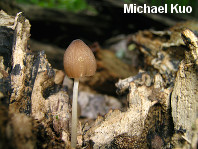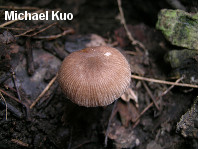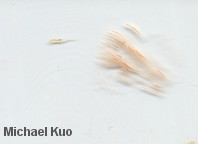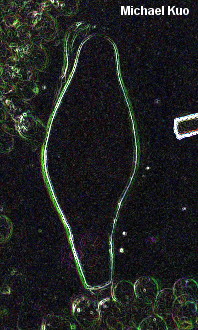| Major Groups > Gilled Mushrooms > Pink-Spored > Pluteus > Pluteus longistriatus |

|
Pluteus longistriatus [ Basidiomycetes > Agaricales > Pluteaceae > Pluteus . . . ] by Michael Kuo This little grayish brown Pluteus is recognized by the long striations that extend from the cap margin nearly to the center of the cap, revealing whitish flesh in the cracks. Like other species of Pluteus, it has a pink spore print and grows on wood. It is a fragile mushroom and, in hot, humid weather, its gills sometimes begin to deteriorate and dissolve--and this can happen before the gills turn pink from maturation of the spores, leading to potential identification confusion. Under the microscope Pluteus longistriatus features thin-walled cystidia, nearly round spores, and a distinctive pileipellis that features a layer of inflated elements arising from a cutis. Description: Ecology: Saprobic on decaying hardwood logs and debris; growing alone or gregariously; summer and fall; widely distributed and common from the Great Plains eastward, and occasionally reported in western North America. The illustrated and described collections are from Missouri and Illinois. Cap: 1-2 cm; convex or slightly bell-shaped at first, becoming broadly convex or nearly flat; fragile; dry; finely, innately, radially fibrillose; developing cracks and fissures that extend from the margin almost to the center; gray-brown to brownish gray. Gills: Free from the stem; close; short-gills frequent; whitish at first, becoming pinkish; soft and, in hot and humid conditions, often collapsing or dissolving. Stem: 3-5 cm long; 1-2 mm thick; equal; bald or with a few fibrils; whitish. Flesh: Insubstantial; pale. Odor and Taste: Not distinctive. Spore Print: Pink. Chemical Reactions: KOH on cap surface negative. Microscopic Features: Spores 5-7 x 4.5-5 µ; broadly ellipsoid to subglobose; smooth; hyaline in KOH; inamyloid. Pleurocystidia 50-75 x 15-35 µ; widely lageniform, utriform, or subcylindric; thin-walled; hyaline in KOH. Cheilocystidia to 50 x 20 µ; subclavate to clavate or widely cylindric; thin-walled; hyaline in KOH. Pileipellis a radial cutis of semigelatinized elements that are brown in KOH, smooth, 5-10 µ wide; terminal cells inflated and upright, cylindric to subclavate, clavate, or cystidioid (fusiform), up to 100 x 25 µ. REFERENCES: (Peck, 1878) Peck, 1885. (Saccardo, 1887; Kauffman, 1918; Singer, 1956; Smith, Smith & Weber, 1979; Arora, 1986; Lincoff, 1992; Barron, 1999; Roody, 2003; McNeil, 2006; Kuo & Methven, 2014.) Herb. Kuo 09170402, 09190605, 08270901. This site contains no information about the edibility or toxicity of mushrooms. |
© MushroomExpert.Com |
|
Cite this page as: Kuo, M. (2004, December). Pluteus longistriatus. Retrieved from the MushroomExpert.Com Web site: http://www.mushroomexpert.com/pluteus_longistriatus.html |






